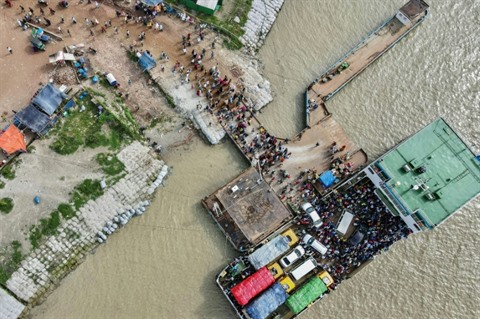>> Bangladesh: 26 dead in the sinking of a ferry
>> Sinking of a ferry in Bangladesh, at least five dead
>> Bangladesh: around ten injured during new demonstrations
|
–
|
|
Aerial view of a stormed ferry in Srinagar, Bangladesh, July 31.
Photo: AFP / VNA / CVN |
While the economy of the South Asian country has been particularly affected by the pandemic, the government has excluded factories supplying major brands in Europe and North America from the new confinement imposed on the entire population.
Authorities have ordered factories, offices, transport and shops to be closed from July 23 until August 5, with the number of new cases and deaths reaching record levels.
Officially, Bangladesh has recorded 1.2 million cases and more than 20,000 deaths since the start of the epidemic but experts estimate that the real toll is four times higher.
Despite the lockdown, the government has announced that the country’s 4,500 garment workshops, which employ four million people, could reopen from Sunday 1is August, causing a rush for industrial poles.
Very influential, the owners of these workshops had warned about the consequences “catastrophic“what their inability to respond on time to orders from their foreign customers.
Many controls
Several hundred thousand workers, returned to their villages to go through confinement and celebrate Eid al-Adha, the main Muslim religious holiday, tried Saturday July 31 to reach the capital, Dhaka, by all means. , some do not hesitate to walk in the monsoon.
 – –
|
|
Workers disembark from the ferry in Srinagar, Bangladesh, July 31.
Photo: AFP / VNA / CVN |
Sign of this exceptional influx, tens of thousands of workers waited hours to be able to board one of the boats leaving the Shimulia ferry station, 70 km south of Dhaka.
“Police carried out numerous checks and the ferry was packed“, explained one of these workers, Mohammad Masun, 25, who left his village at dawn, walking more than 30 km before taking rikshaws, to reach the pier.
“It was a frantic race to get home when the lockdown was announced and now we are having the same difficulties returning to work“, lamented another worker, Jubayer Ahmad.
The second largest textile exporter after China, Bangladesh, with a population of 169 million, has seen this industry become one of the cornerstones of its economy.
Bangladesh Fabric Manufacturers and Exporters Association vice-president Mohammad Hatem said orders worth nearly $ 3 billion could be lost to the industry if factories remained closed.
“The big brands would have gone to other countries“, he assured.
AFP / VNA / CVN
– .


